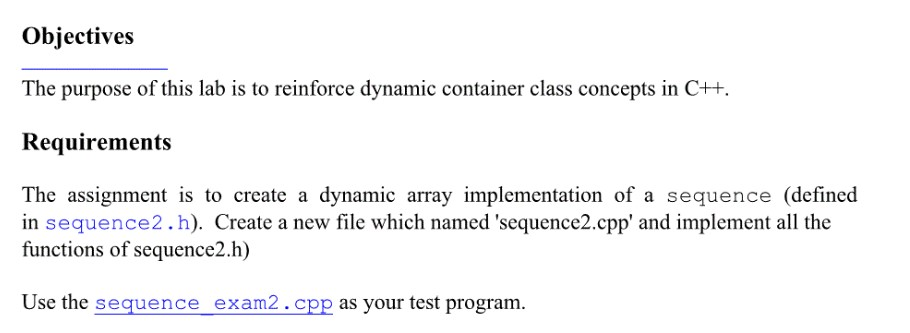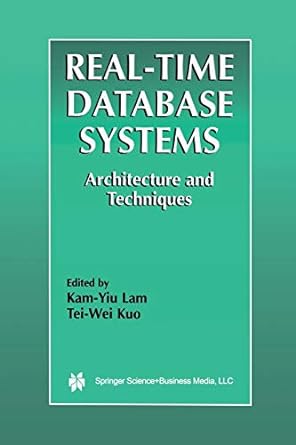Question
sequence2.h ====== // FILE: sequence2.h // CLASS PROVIDED: sequence (part of the namespace main_savitch_4) // There is no implementation file provided for this class since

sequence2.h ======
// FILE: sequence2.h // CLASS PROVIDED: sequence (part of the namespace main_savitch_4) // There is no implementation file provided for this class since it is // an exercise from Chapter 4 of "Data Structures and Other Objects Using C++" // // TYPEDEFS and MEMBER CONSTANTS for the sequence class: // typedef ____ value_type // sequence::value_type is the data type of the items in the sequence. It // may be any of the C++ built-in types (int, char, etc.), or a class with a // default constructor, an assignment operator, and a copy constructor. // // typedef ____ size_type // sequence::size_type is the data type of any variable that keeps track of // how many items are in a sequence. // // static const size_type DEFAULT_CAPACITY = _____ // sequence::DEFAULT_CAPACITY is the initial capacity of a sequence that is // created by the default constructor. // // CONSTRUCTOR for the sequence class: // sequence(size_t initial_capacity = DEFAULT_CAPACITY) // Postcondition: The sequence has been initialized as an empty sequence. // The insert/attach functions will work efficiently (without allocating // new memory) until this capacity is reached. // // MODIFICATION MEMBER FUNCTIONS for the sequence class: // void resize(size_type new_capacity) // Postcondition: The sequence's current capacity is changed to the // new_capacity (but not less that the number of items already on the // list). The insert/attach functions will work efficiently (without // allocating new memory) until this new capacity is reached. // // void start( ) // Postcondition: The first item on the sequence becomes the current item // (but if the sequence is empty, then there is no current item). // // void advance( ) // Precondition: is_item returns true. // Postcondition: If the current item was already the last item in the // sequence, then there is no longer any current item. Otherwise, the new // current item is the item immediately after the original current item. // // void insert(const value_type& entry) // Postcondition: A new copy of entry has been inserted in the sequence // before the current item. If there was no current item, then the new entry // has been inserted at the front of the sequence. In either case, the newly // inserted item is now the current item of the sequence. // // void attach(const value_type& entry) // Postcondition: A new copy of entry has been inserted in the sequence after // the current item. If there was no current item, then the new entry has // been attached to the end of the sequence. In either case, the newly // inserted item is now the current item of the sequence. // // void remove_current( ) // Precondition: is_item returns true. // Postcondition: The current item has been removed from the sequence, and the // item after this (if there is one) is now the new current item. // // CONSTANT MEMBER FUNCTIONS for the sequence class: // size_type size( ) const // Postcondition: The return value is the number of items in the sequence. // // bool is_item( ) const // Postcondition: A true return value indicates that there is a valid // "current" item that may be retrieved by activating the current // member function (listed below). A false return value indicates that // there is no valid current item. // // value_type current( ) const // Precondition: is_item( ) returns true. // Postcondition: The item returned is the current item in the sequence. // // VALUE SEMANTICS for the sequence class: // Assignments and the copy constructor may be used with sequence objects. // // DYNAMIC MEMORY USAGE by the List // If there is insufficient dynamic memory, then the following functions // throw a BAD_ALLOC exception: The constructors, insert, attach.
#ifndef MAIN_SAVITCH_SEQUENCE_H #define MAIN_SAVITCH_SEQUENCE_H #include // Provides size_t
namespace main_savitch_4 { class sequence { public: // TYPEDEFS and MEMBER CONSTANTS typedef double value_type; typedef std::size_t size_type; static const size_type DEFAULT_CAPACITY = 30; // CONSTRUCTORS and DESTRUCTOR sequence(size_type initial_capacity = DEFAULT_CAPACITY); sequence(const sequence& source); ~sequence( ); // MODIFICATION MEMBER FUNCTIONS void resize(size_type new_capacity); void start( ); void advance( ); void insert(const value_type& entry); void attach(const value_type& entry); void remove_current( ); void operator =(const sequence& source); // CONSTANT MEMBER FUNCTIONS size_type size( ) const; bool is_item( ) const; value_type current( ) const; private: value_type* data; size_type used; size_type current_index; size_type capacity; }; }
#endif
Objectives The purpose of this lab is to reinforce dynamic container class concepts in C++. Requirements The assignment is to create a dynamic array implementation of a sequence (defined in sequence2.h). Create a new file which named 'sequence2.cpp' and implement all the functions of sequence2.h) Use the sequence exam2.cpp as your test program. Objectives The purpose of this lab is to reinforce dynamic container class concepts in C++. Requirements The assignment is to create a dynamic array implementation of a sequence (defined in sequence2.h). Create a new file which named 'sequence2.cpp' and implement all the functions of sequence2.h) Use the sequence exam2.cpp as your test program
Step by Step Solution
There are 3 Steps involved in it
Step: 1

Get Instant Access to Expert-Tailored Solutions
See step-by-step solutions with expert insights and AI powered tools for academic success
Step: 2

Step: 3

Ace Your Homework with AI
Get the answers you need in no time with our AI-driven, step-by-step assistance
Get Started


